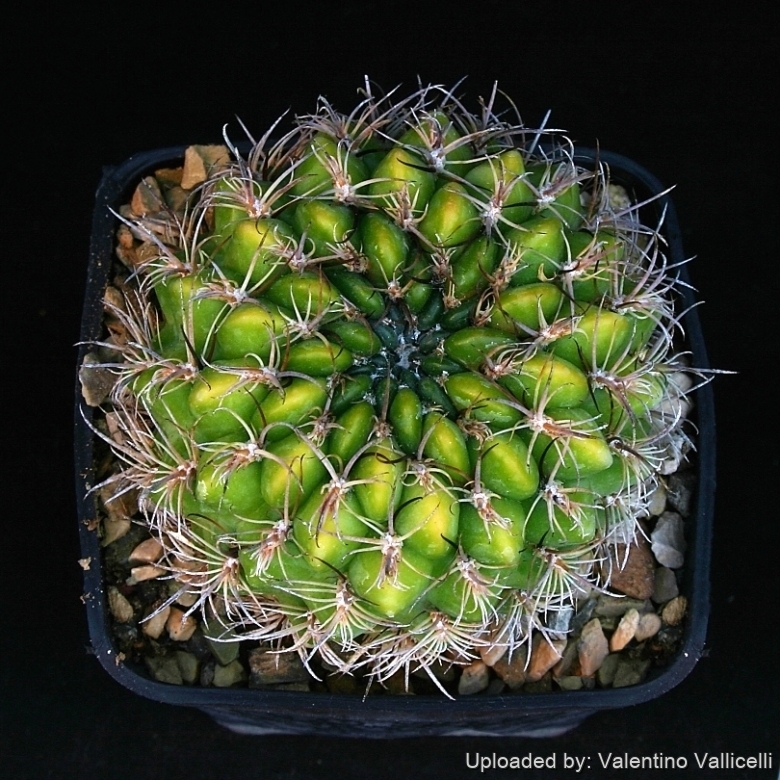= Echinopsis tiegeliana f. variegata hort.
Accepted Scientific Name: Echinopsis tiegeliana (Wessner) D.R.Hunt
Bradleya 9: 88. 1991

Lobivia tiegeliana f. variegata (Echinopsis tiegeliana f. variegata) Photo by: Valentino Vallicelli
Origin and Habitat: Garden origin (Nursery produced cultivar)
Synonyms:
See all synonyms of Echinopsis tiegeliana
back
Accepted name in llifle Database:Echinopsis tiegeliana (Wessner) D.R.HuntBradleya 9: 88. 1991Synonymy: 34
back
Description: The classical Echinopsis tiegelianaSN|20965]]SN|20965]] (Lobivia tiegeliana) is a small cactus with a much flattened usually solitary body, whose spines looks pectinate ( i.e., its spines are arranged like a comb). The variegated form (Echinopsis tiegelianaSN|20965]]SN|20965]] f. variegata) has sectors, patches or stripes with distinct shades of yellow. A very few variegated plants sprout unpredictably time by time among normal green seedling and are very rare. Plants with variegated stems are often attractive and highly prized.
Roots: Large fleshy tap root.
Stems: Glossy green and yellow, often purplish with strong light and in cold weather, depressed or spherical up to 15 cm in diameter, but usually about 6 cm broad. The crown is sunken.
Ribs: 17-20, acute, spirally arranged with raised tubercles between which the areoles appear.
Areoles: White, to 1,5 cm apart.
Spines: Arranged like little spiders, awl shaped, pectinated, variable, reddish, black, brownish, honey or horn coloured , often darker at the tip, turning greyish eventually.
Central spines: As many as 3, pointing downward, to 5 cm long.
Radial spines: 8 to10, 4-6 cm long.
Flowers: Lateral 2,5-3 cm long and 4,2 cm in diameter, deep red to violet-pink, although there are varieties with yellow flowers as well.
Blooming season: Mature plants produce several waves of blooms over the season. The flowers open during the day. It blooms abundantly since an early age.
Fruits: Globose to ovoid, semidry, dehiscent.
Subspecies, varieties, forms and cultivars of plants belonging to the Echinopsis tiegeliana group
Bibliography: Major references and further lectures
1) Nathaniel Lord Britton, Joseph Nelson Rose “Cactaceae: Descriptions and Illustrations of Plants of the Cactus Family” Courier Dover Publications, 1963
2) James Cullen, Sabina G. Knees, H. Suzanne Cubey “The European Garden Flora Flowering Plants: A Manual for the Identification of Plants Cultivated in Europe, Both Out-of-Doors and Under Glass” Cambridge University Press, 11/Aug./2011
3) David Hunt, Nigel Taylor “The New Cactus Lexicon” DH Books, 2006 ISBN 0953813444, 9780953813445.
4) Edward F. Anderson “The Cactus Family” Timber Press, 2001
5) Clive Innes, Charles Glass “Cacti” Portland House, 01/May/1991
Cultivation and Propagation: Variegated cacti are regarded as choice and difficult in cultivation, but despite that many of them are relatively easy to grow. But be aware that they cannot tolerate prolonged exposure to direct sun light (especially during the hottest summer days), so grow them in half-shade or under filtered sun. They are sometime seen as grafted plants, but some of this colourful plants (those with some chlorophyll) are able to grow on their own roots and are priced by collectors.
Soil: Use mineral well-permeable substratum with little organic matter (peat, humus).
Watering: Water sparingly from March till October, and keep perfectly dry in winter, at temperatures from 5 to 15 degrees centigrade. (In general these plants are more tender and cannot endure freezing temperatures). In the rest period no high atmospheric humidity!!
Propagation: By seeds, grafting or cutting. Because the variegation is due to the presence of two kinds of plant tissue, propagating the plant must be by a vegetative method of propagation that preserves both types of tissue in relation to each other. A most common way way to cultivate this partially de-coloured cultivars is to graft them onto another cactus which has chlorophyll and which will provide sugar to the mutant scion. The chlorophyll containing bottom part of the graft, called the stock, can be any number of different columnar cactus species.
Remarks: Seeds from variegated parents often give raise to some variegated seedlings too.










